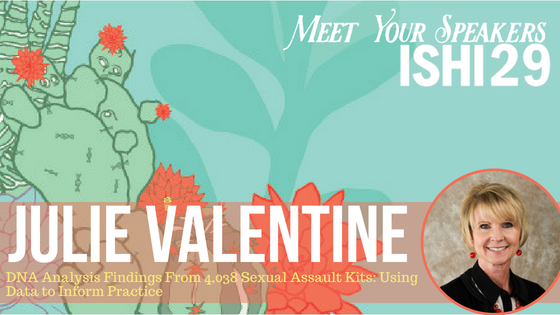A collaborative database was created in Utah to link data on sexual assault kits (SAKs) from evidence collection through submission to the state crime laboratory and DNA analysis. To date, approximately 250 variables per sexual assault kit have been coded on 4,038 cases from 2010 to 2016 throughout Utah. Due to the large amount of data, multiple research studies are being conducted utilizing the database.
In their presentation at ISHI, Julie Valentine (Assistant Professor at Brigham Young University and Forensic Nurse at SANE-A Wasatch Forensic Nurses) and Suzanne Miles (Forensic Scientist Manager in the Serology Section at the Utah Dept. of Public Safety) will share information on the DNA analysis findings from the 4,038 SAKs that were submitted for testing from 2010 to 2016 to inform practice for both forensic nursing/medical providers and forensic scientists.
We sat down with Julie and asked her how the database was created, if any surprises arose when analyzing the data, and what her tips are for those getting started in forensics.
Hi Julie, thank you for talking with us today. The sexual assault backlog continues to be top of mind in United States, and I know that attendees will gain a lot from your presentation.
Your abstract mentions a database that was created in Utah for Sexual Assault Kits. When was the database created and what is its purpose?
The database was created in 2012 as a collaborative project between the state crime lab, Utah Bureau of Forensic Services, and researcher, Dr. Julie Valentine. The purpose of the database was to aggregate data from thousands of sexual assault cases with evidence collected by forensic nurses or medical examiners with data from the state crime lab. In essence, to track information from sexual assault kits from evidence collection through DNA analysis. A multitude of studies have now resulted from the database including analyzing sexual assault kit submission rates and predicting variables related to submission. In addition, several studies are examining victims’ legal and extralegal variables and sexual assault characteristics.
How did you become involved in the project to analyze the data collected from DNA samples?
I developed the idea of the database and approached Utah Bureau of Forensic Services about collaborating to develop the database.
Did anything surprise you as you analyzed the data?
There have been many surprises along the way since we began analyzing the data in 2013. The low sexual assault kit submission rates was a surprise. Information on mental and physical health characteristics of victims has been surprising. Some of the DNA findings were unexpected and will be shared at the ISHI presentation.
Which research findings will be included in your ISHI presentation? What can attendees expect to learn from your presentation?
Attendees will learn about DNA analysis findings in aggregate form and predicting variables for development of a full STR DNA profile, a full YSTR DNA profile, and CODIS eligible profiles. One of the important aspects of this study is that this is information in practice on a very large amount of sexual assault cases. We need this information to help guide best practices.
How did you become interested in forensic science?
I have been a forensic nurse since 2005. I immediately became fascinated by the DNA analysis methods and findings related to evidence collection. I realized that we needed studies linking forensic evidence collection to forensic evidence analysis findings to develop best practice guidelines leading to evidence-based practice.
What do you feel is the biggest challenge that forensic laboratories are facing today?
Resources!! With the increased amount of sexual assault kits and other evidence submitted to forensic laboratories for DNA analysis, crime laboratories need additional support and funding to meet the increased caseload.
What tips would you give to someone who is just starting out in the forensics field, or what is the best advice that you’ve received?
Always ask questions and work hard to find the answers.
For those still deciding whether to attend, what is your favorite thing about ISHI, or what are you most looking forward to this year?
Learning about new DNA technologies and advancements and connecting with colleagues.
What’s one thing that others may not know about you?
I have 8 wonderful children, along with a great husband.
WOULD YOU LIKE TO SEE MORE ARTICLES LIKE THIS? SUBSCRIBE TO THE ISHI BLOG BELOW!
SUBSCRIBE NOW!


